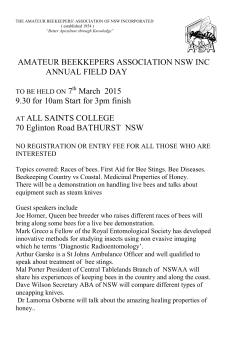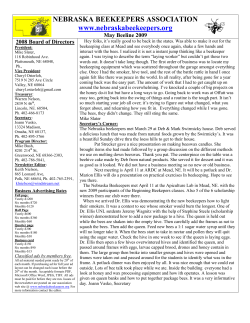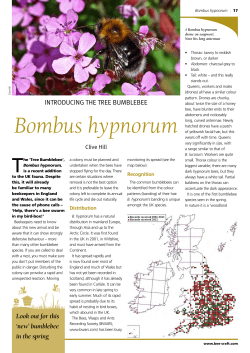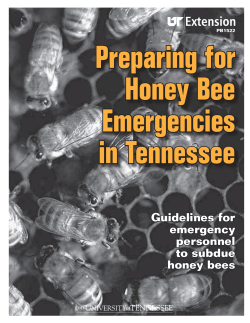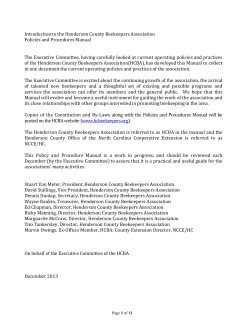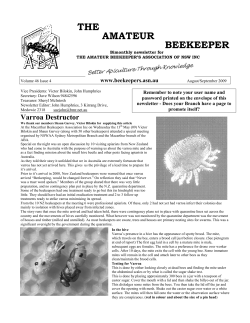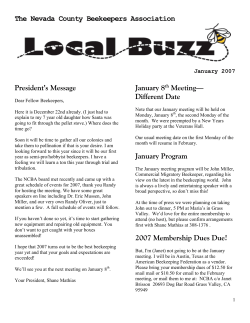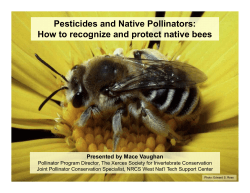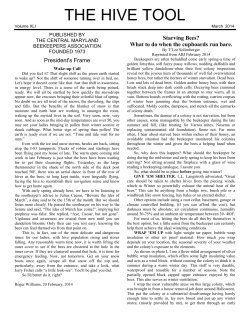
NEWS BEEKEEPING
BEEKEEPING
NEWS
J uJlAyN, U A RAY u•g uF sEtB, R U A RSYe p• t M
em
AR
b eC rH • 2 021011 3
a local chapter of N O R T H C A R O L I N A S TAT E B E E K E E P E R S A S S O C I AT I O N , I N C .
•Tuesday, July 9th, 6:30 p.m. (bring side dishes & desserts) Get hamburger & hot dog for $2.00
Bring your favorite beekeeping gadget or idea for our Show & Tell Meeting. Members will have about 5
minutes each to share ideas or beekeeping items they have made/found to make beekeeping easier.
•Tuesday, August 13th, 6:30p.m. (no meal)
Dr. Wick Wickliffe, Guilford County Extension Director of NC Cooperative Ext. discusses agriculture
and farming in Guilford County to follow up on our May & June discussions regarding the potential for
backyard beekeeps and small farmers working together to provide safe pollinator environments.
•Tuesday, September 10th, 6:30 p.m. (covered dish meal)
Cindy Loving will explain Aroma Therapy, Essential Oils, and how these sents can be used. This is a
chance for us to expand our knowledge beyond the use of lemongrass oil as a swarm lure.
Bee Venom Kills HIV (Just Another Reason To Save The Bees!)
Beth Buczynsk•
March 29, 2013
{get healthy living updates}
Colony collapse disorder is decimating bee populations around the world. The
possibility of losing our planet’s most industrious pollinator hasn’t motivated agencies like the
EPA to protect them, but maybe this will: A team at Washington University School of Medicine
in St. Louis recently used nanoparticles carrying a toxin found in bee venom to destroy HIV
without harming nearby cells.
According to study results, which appear in the current issue of Antiviral Therapy, bee
venom contains a potent toxin called melittin that can poke holes in the protective envelope
that surrounds HIV, and other viruses. The paper’s senior author, Samuel A. Wickline, MD, the
J. Russell Hornsby Professor of Biomedical Sciences, has even shown that melittin-loaded
nanoparticles to be effective in killing tumor cells.
What other naturally occurring substance do you know of that can tackle both HIV and
cancer? Exactly.
The study’s authors believe that with further research, they could be able to create a
vaginal gel, loaded with the bee venom particles, that could help prevent the spread of HIV.
According to Joshua L. Hood, a research instructor in medicine involved in the study,
most anti-HIV drugs inhibit the virus’s ability to replicate. But this anti-replication strategy does
nothing to stop initial infection, and some strains of the virus have found ways around these
drugs and reproduce anyway. The bee venom toxin is different because it attacks an essential
part of the virus’ structure. The melittin forms little pore-like attack complexes and ruptures the
envelope, stripping it off the virus.
“We are attacking an inherent physical property of HIV,” Hood says. “Theoretically,
there isn’t any way for the virus to adapt to that. The virus has to have a protective coat, a
double-layered membrane that covers the virus.”
Because the bee venom toxin has been engineered not to attack healthy cells, a
vaginal gel could be ideal for couples where one partner has HIV and they want to have a
baby. It’s also theoretically possible that intravenous injections of the nanoparticles would be
able to clear HIV from the blood stream, a virtual miracle for those who have tested positive.
Perfecting this treatment will take years. Let’s just hope the bees survive that long.
Wouldn’t it be a shame to see a potential cure for HIV lost because we were too busy
dumping bee-killing pesticides on everything in sight?
Read more: http://www.care2.com/greenliving/bee-venom-kills-hiv-just-another-reason-tosave-the-bees.html#ixzz2Sdm9QiKe
NC State researcher says bee colonies are
healthier when queens take many mates
Read more here: http://www.newsobserver.com/2013/06/17/2971194/nc-state-researchersays-bee-colonies.html#storylink copy By Renee Elder — relder@newsobserver.com
RALEIGH — Queen bees who cavort with multiple mates are not behaving badly. In fact, such
procreative preferences actually help honeybee colonies survive by bringing more genetic diversity
into the mix, according to a new study by entomology researchers at N.C. State University and other
institutions.
“High genetic diversity produces more eggs that resist disease better, and those colonies function
more efficiently than less-diverse colonies do,” said David Tarpy, NCSU associate professor of
entomology and lead author of the research paper published this month in the scientific journal
“Naturwissenschaften,” based in Germany.
Tarpy said the findings are part of a long-range study into potential causes of colony collapse
disorder, a mysterious condition in which a colony’s worker bees all disappear. The disorder was first
identified in 2006, when some beekeepers reported losses of a third to 90 percent of their hives.
While losses have not been as large recently in North Carolina, the condition still occurs here, said
Don Hopkins, who oversees beekeeping operations for the N.C. Department of Agriculture and
Consumer Services.“The concern among beekeepers is just as strong as it ever has been,” Hopkins
said.
Numerous factors may adversely affect bee colonies, including pests such as the varroa mite which
feeds on bee larvae and pupae. Other potential problems for hives include certain types of bacteria,
applications of pesticides or insufficient food supplies. When such problems arrive, a diverse genetic
mix could be a valuable asset for a colony.
“Mixing the genes in a given colony helps to hedge their bets, so if some members of the colony
aren’t doing so well, their half-sisters can take up the slack,” Hopkins said. While other research has
focused directly on analyzing collapsed colonies, Tarpy and his colleagues looked at the genetic
diversity of bees in hives in the spring and again at the end of the summer. “We found that colonies
with low levels of genetic diversity were more likely to die by the end of that period,” Tarpy said. He
said the research findings don’t fully explain mysterious colony collapse disorder, but “could be a
piece of the puzzle.”
By taking samples from 80 honeybee colonies and evaluating their genetic diversity, Tarpy and >
his colleagues – Dennis vanEnglesdorp at the University of Maryland and Jeffery S. Pettis at the
USDA Bee Research Laboratory in Beltsville, Md. – determined that colonies whose queens had
mated seven or more times were nearly three-times more likely to survive to the end of the 10-month
honeybee working season than those who mated fewer times.
About half – 48 percent – of those colonies whose queens had seven or more mates survived. Fewer
than 20 percent of the less genetically diverse colonies made it to the end of the 10-month period.
A single queen typically lays all the eggs for an individual hive, which can support as many as 80,000
bees, including male drones and infertile female worker bees, Hopkins said. A newly emerged queen,
known as a virgin queen, goes out on mating flights within days of becoming an adult bee. “She flies
from the hive to sow her wild oats, mating with drones from other colonies,” Tarpy said. Each queen
makes at least one and sometimes four or five trips from the hive during a period of about a week,
staying out for a few hours each time and mating with one or more drones per trip.
The queen flies to areas where male bees gather, and finds suitors strong enough to fly alongside her
as they mate in the air. After mating, the drone will die, because the males’ sex organs and part of its
abdomen are torn away at the conclusion of the act. This leaves the queen ready to receive a new
mate – and a new set of genetic material – with each coupling.
Some queens conclude their mating ritual after mating a half-dozen or fewer times, while others mate
with 30 or more drones. Then the queen returns to the hive to lay eggs. She never mates again, but
continues to lay the fertilized eggs she has stored in her body to produce workers or queen bees.
Drones develop from nonfertilized eggs.
Tarpy said the research study was also significant because it examined bees in as natural a setting
as possible. The colonies examined are those transported to farms and agricultural settings on a
regular schedule to pollinate crops along the East Coast. “These were real-world pollinators, the ones
responsible for putting food on our tables,” Tarpy said.
Read more here: http://www.newsobserver.com/2013/06/17/2971194/nc-state-researcher-says-beecolonies.html#storylink=cpy
Bee Deaths From Colony
Collapse Disorder On The Rise As
Researchers Point To Pesticides
The Huffington Post | By James GerkenPosted: 03/29/2013
Honeybee deaths are on the rise across the world, and researchers are working to find the cause.
With as many as 40 or 50 percent of commercial U.S. bee hives lost to colony collapse disorder,
according to the New York Times, scientists are eyeing a relatively new class of pesticides as a likely
culprit.
Neonicotinoids, which are chemically similar to nicotine, have already been shown to interfere
with bees’ capacity to learn scents, hampering their efforts to collect food.
Colony collapse disorder -- which follows a “sudden loss of a colony’s worker bee population,”
according to the Environmental Protection Agency -- may be relatively new. It first surfaced around
2005, the New York Times explains, but has gotten dramatically worse in the past year.
The European Commission has been pushing for a neonicotinoid pesticide ban in the EU, but
chemical companies have been protesting. Syngenta and Bayer, two of the top producers of the
pesticides, recently proposed a plan to expand bee habitats and increase monitoring in an attempt
avoid restrictions on their products.
In the U.S., a group of environmentalists and beekeepers recently filed suit against the EPA for
approving the pesticides. Neonicotinoids, they wrote in the lawsuit, have been “repeatedly identified
as highly toxic to honeybees, clear causes of major bee kills and significant contributors to the
devastating ongoing mortality of bees known as colony collapse disorder,” reported Bloomberg.
The U.S. Department of Agriculture is expected to issue its own assessment later in the spring,
according to the New York Times.
A recent study published by the American Bird Conservancy found that the pesticides may also
negatively impact birds and water-borne insects. Mother Jones notes the report hasn’t been peerreviewed, but was authored by a retired senior research scientist formerly with Canada’s environment
ministry.
Pesticide Lobby
Spends Millions To
Defend Chemicals
Tied To Bee Deaths
Posted: 03/29/2013 4:24 pm EDT | Updated: 03/29/2013 6:48 pm EDT
WASHINGTON -- The chemical pesticide lobby is waging a multi-million dollar battle to prevent
regulation of chemicals linked to the dramatic escalation in the deaths of pollinating bees over the
past year.
CropLife America, the trade association that represents more than 90 of the world’s biggest
agro-chemical manufacturers, spent nearly $2.5 million last year lobbying against bills that sought to
increase oversight of chemical manufacturing and transfer, strengthen drinking water standards and
fund research into the effects of pesticides on humans.
The lobbying expenses are part of an ongoing lobbying blitz launched in 2010 by the pesticide
industry to fight any efforts by the Obama administration to regulate pesticides. Since 2008, Croplife
America has poured $11.2 million into lobbyists, and another $643,000 into a PAC that backs
congressional candidates sympathetic to the chemicals industry.
One class of pesticides that has international scientists and beekeepers increasingly worried are
called neonicotinoids -- a chemical cousin of nicotine. Neonicotinoids are genetically embedded into
seeds before they are planted, and last much longer than traditional spray pesticides. Last week a
group of beekeepers and environmental groups filed a lawsuit against the Environmental Protection
Agency over its approval of certain neonics, as they are known.
CropLife argues that neonics are safe, and CropLife America president Jay Vroom told The
New York Times this week that science “supports the notion that the products are safe and are not
contributing in any measurable way to pollinator health concerns.” In 2011, Vroom earned $826,146
in salary and benefits from Croplife and its related entities.
The current chairman of Croplife America is John Croshniak, a pesticide specialist at the chemical
giant DuPont. The former chairman, who stepped down in 2011, is Bill Bucknell, a senior executive in
the pesticides division of Bayer, another one of the world’s largest chemical manufacturers.
EPA tour reveals 7 in 10 beehives dead
April 19, 2013
The plague killing off American honey bees, a growing concern in Congress, has now been witnessed
by administration environmental officials who are also looking into beekeeper complaints that too
many pesticides are being approved and that illegal use of the insecticides is going unpunished.
Industry officials said that an assistant Environmental Protection Agency administrator last month
toured a California bee farm and saw the devastation. Owner Jeff Anderson said that of the 3,150 hives
he had last spring, just 992 have survived.
He and other industry officials added that the death rate of honey bees critical for fruit, nut and
vegetable pollination, has reached such a crisis that many professional beekeepers can’t afford to
replace their colonies and are getting out of the business.
“Beekeepers will just not be able to recover from these losses,” added Bret Adee, president of the
National Pollinator Defense Fund. He told the industry trade Bee Culture that the lack of bees will
result in smaller crops and “I expect that next year may be worse.”
The industry has been on a crusade to get the EPA’s help in halting the approval of bee-killing
pesticides. They also want those who use pesticides illegally to be punished. The EPA has been focusing
more recently on the issue, even limiting the use of one pesticide.
On Monday, Earth Day, groups dedicated to the bee are launching a campaign called BEE Protective to
push for changes to pesticide rules in Washington.
Many in the honey industry believe that the mysterious Colony Collapse Disorder is in part the result
of new and stronger pesticides that remain potent for years, meaning that they are in the pollen bees
collect over time. Bee Culture reported that a Pennsylvania State University study of 800 hives found
six different kind of pesticides inside. The study called it a “remarkably high level for toxicants in the
food of brood and adults” in the hive.
Wash. state pressed to save honey
bees by restricting pesticides by Tom Banse
This is the time of year when local farmers count on bees and other insects to pollinate
orchards and vegetable and berry fields. The change in the seasons is not the only thing
creating a buzz in the world of beekeeping.
This week, the European Commission put
a moratorium on the use of three popular
pesticides judged to pose high risk to bees.
Beekeepers have started to push Washington
State’s Department of Agriculture to go in that
direction, too. And that could have an effect on
what’s available at your local garden center.
When they die off, you feel that you’ve
failed’
Honey bees can forage up to 5 or 6 miles from their hive.
For about seven years, many Western
beekeepers have been plagued by unexplained
die-offs in their hives. It happened recently to
Mark Emrich.
“Well, I was doing great until about five weeks ago. Then I came down and opened up the
hives, and I had five dead boxes of bees. That was a huge hit,” said Emrich, who lost onethird of his production.
Emrich sports a bushy beard and a ball cap with the logo of the Washington State
Beekeepers Association. He’s the group’s president. Emrich shows no fear of being stung as
he gently lifts a lid to check on his remaining bees. They shelter inside hives on his small farm
near Olympia.
“It is very hard to deal with bee losses,” he said. “They are kind of like your little livestock and
you try to really manage them and take care of them the best you can. When they die off, you
feel that you’ve failed.”
No plan to impact big agriculture
Even before the die-off in his hives, Emrich was writing letters to government officials. He
wants some potentially-risky and widely-used pesticides pulled from store shelves.
But here’s a twist. The Washington beekeepers propose to leave big agriculture alone.
Rather, they’re targeting home and garden use of common bug killers, rose and flower
treatments, and grub controls.
“We have people who are using it who don’t understand all the implications and the labeling is
inadequate as far as what it actually will kill. So basically, the idea is at least we’ll get it out of
the hands of the general public,” Emrich said.
The neonicotinoid pesticide imidacloprid is the active ingredient in many retail insecticides.
Not harmful, say pesticide makers
The insecticides in question belong to a class called neonicotinoids. “Neonics,” for short,
appear in more than a hundred different garden products sold under brand names such as
Bayer, Ortho and Scotts.
A range of studies have shown significant adverse affects on bees exposed to high doses in
the lab, but separate studies using more realistic field conditions show minimal harm or are
inconclusive.
Pesticide makers argue banning neonics would not save a single hive.“If we use these
products according to the label, then we don’t see an effect on pollinators—or honey bees—
that are contiguous to these fields where we’re using these products,” said Barb Glenn who
oversees science and regulatory affairs for an industry association called CropLife America.
Glenn says it’s in her industry’s best interest to safeguard bees because agriculture needs
pollinators to thrive. In her view, many factors conspire against bee survival. Glenn ticks off a
list.
“Diseases. Parasites. It includes the availability of habitat and also cultural practices and
nutrition. Pesticide use is also a part of that continuum,” she said.
‘There’s not a consensus’ For what it’s worth, her list looks almost the same as what I get
from independent researchers at Oregon and Washington State Universities.
WSU entomologist Steve Sheppard says a lot of new research is focusing on the pesticide
angle.“There’s not a consensus, I think, in the scientific community that the levels that
are found in agricultural crops for example have been directly linked to colony losses,” he
said. “But some countries, in Europe for
example, have taken a more prudent
approach to not use those pesticides until
they feel all of the data are in.”
That’s also the gist of the petition for
rulemaking before the Washington State
Department of Agriculture. The agency’s
initial response was to ask all affected
parties to send in their best science. The
state plans to announce in early June
whether it sees enough evidence to draft
tighter rules for home and garden bug
killers.
May 8, 2013
ABJ EXTRA
Winter Loss Survey 2012 2013:
Preliminary Results
by Dennis vanEngelsdorp1*, Nathalie Steinhauer1, Karen Rennich1, Jeffery Pettis2, Eugene J. Lengerich3, David Tarpy4,
Keith S. Delaplane5, Angela M. Spleen3, James T. Wilkes6, Robyn Rose7, Kathleen Lee8, Michael Wilson9 , John Skinner9 ,
and Dewey M. Caron10 for the Bee Informed Partnership.
The Bee Informed Partnership (http://beeinformed.org), in collaboration with the Apiary Inspectors of America
(AIA) and the United States Department of Agriculture (USDA), is releasing preliminary results for the seventh
annual national survey of honey bee colony losses. For the 2012/2013 winter season, a total of 6,287 U.S.
beekeepers provided validated responses. Collectively, responding beekeepers managed 599,610 colonies in
October 2012, representing about 22.9%1 of the country’s estimated 2.62 million colonies.
Preliminary survey results indicate that 31.1% of managed honey bee colonies in the United States were lost
during the 2012/2013 winter. This represents an increase in loss of 9.2 points or 42% over the previous 2011/
2012 winter’s total losses that were estimated at 21.9% (Figure 1). This level of loss is on par with the 6 year
average total loss of 30.5%2.
On average, U.S. beekeepers lost 45.1% of the colonies in their operation during the winter of 2012/2013.
This is a 19.8 point or 78.2% increase in the average operational loss compared to the previous winter (2011/
2012), which was estimated at 25.3%. The difference between average loss and total loss is explained by the
respondent pool: while a majority of the respondents (95%) were backyard beekeepers, they managed a small
fraction of the colonies represented in the survey (6%). For this reason total loss (which is more heavily
influenced by commercial beekeeper losses) is more representative of national losses.
Survey participants indicated that they considered a loss rate of 15% as “acceptable,” but 70% of them suffered
losses greater than this.
1 Based on NASS 2012 figures
2 Previous survey results found a total colony loss in the winters of 21.9% in the winter of 2011/2012, 30% in
2010/2011, 34% in 2009/2010, 29% in 2008/2009, 36% in 2007/2008, and 32% in 2006/2007 (see figure below)
The Bee Informed Partnership is funded by the National Institute of Food and Agriculture, USDA.
Our news letter is too short to keep up. There are sooo many good articles out there now. Here are a
few more that you may want to check on your computer. Search by title or arthor.
Beeeprotection: US in spotlight as EU bans pesticides
European commission vote highlights threat to the world’s food supply from the
decline of bees and other pollinators
How a new class of pesticides transformed
the agrochemical landscape for bees
Natural News.com Real News Powered by the People, Naturally.
Scientists call for global ban on bee-killing pesticides
Honey may hold the sticky solution to bee
colony collapse By Geoffrey Mohan
Honey could be a potent medicine as well as a tasty treat
by Rosemary Stanton
Sunday, 23 June 2013 Article written by Scott Helman
How a Harvard scientist, a sixth-generation bee whisperer, and a
retired entrepreneur joined forces to rescue an embattled insect
and save the American food supply.
Center for Food Safety Applauds
Passage of Pollinator Protection Amendment in Farm Bill
June 20th, 2013
The Center for Food Safety applauds the passage of a pollinator protection amendment
yesterday that was offered by Congressman Alcee Hastings (D-FL) to the Farm Bill currently being
considered by the U.S. House of Representatives, a fitting and positive development during National
Pollinator Week. (I think that means we should say our prayers)
Our web site, www.guilfordbeekeepers.org is your source for
local beekeeping information, questions, and answers.
Sign up for our forum board and join the conversation!
Robert Jacobs, President
James Brown, Vice President
Levern Allen, Secretary
Ruth Edwards, Treasurer
Directors
Don Berckman, Jack Fleming,
Sam Coble
Newsletter Editor, Norman Faircloth
• Don Hopkins, State Inspector: (336) 376-8250
• Guilford County Beekeepers Association web
site www.guilfordbeekeepers.org
• North Carolina State Beekeepers Association
www.ncbeekeepers.org
Guilford County Beekeepers Association
A LOCAL CHAPTER OF THE NORTH CAROLINA STATE BEEKEEPERS
Norman Faircloth, editor (nfaircloth@northstate.net)
EDITORIAL
:As the editort, I have looked over lots of Beekeeping & related
articles in considering what you may think most interesting and benficial to you and your
bees. And there are many of them! My OLD friend, Emerson Heatherly, was telling me a few
weeks ago about an article he read which should have burned my ears. It stated that, and I’m
paraphrasing here, that the low-life characters who didn’t treat their bees with the prescribed
medications are the cause of all the bad luck those “good guys”, are having with mites, etc., by
“growing mites” to invade his beeyard. (Helping the enemy, as it were.)
Emerson knew that would get my attention since I gave up on the varroa poisons, corn syrup,
etc. long ago. I guess I could qualify as “organic” in my bee yard. Here is an article which should
give me a little cover. Norman
The March 2013 issue of Bee Culture Magazine published an article by Dr. Buddy
Marterre, a sergeon and long time beekeeper in Winston Salem. He is a world traveler in
medical misson work and has held offices in our NC Beekeepers Association prior to the
cutbacks by NC State University. The following is copied from Dr. Buddy’s article.
“Why Treat For Varroa? by Dr. Buddy Marterre
Well there are good reasons but they might not be what you think. If you thought:
•because if I don’t I will loose all my bees (or)
•so I can have 100% overwinter survival (or)
•the Varroa mites are worse than the treatment effects on the colony (then)
Think again. Varroa mites are a serious threat to our honey bees and treatments do increase a colony’s chance of survival, but not as much as you might think. And treatments
certainly guarantee your colony’s survival nor prevent overwinter loss. Futhermore, treatments do come at a serious cost to both your colony’s health and your budget. And it is
my belief that many beekeepers treat out of fear which is not a good reason.”
Be a Good Doctor You may know that I’m a doctor when I’m not beekeeping. When
you treat your bee colony with anything, YOU are your bees’ doctor (or perhaps Veterinarian). So imagine for me, if you will, what it would be like to go to your doctor with a
lethal illness like cancer (not too very different from Varroa mites in a colony of bees).
Do you expect 100% cure from chemotherapy? Do you expect no side effects? What does
your doctor tell you? Probably something about marginal benefit and risk. So what’s
that you say? Marginal benefit is the amount of you receive over doing nothing. In other
words, if you have a 70% chance of survival with no treatment and an 80% chance of servival with chemotherapy, the marginal benefit (of chemotherapy) is 10%. And then there
are the risks of treatment.
ALL Varroa treatments are bad
for honey bees ALL miticides used
inside bee hives, whether natural or
what is commonly called “soft” treatments (organic acids and essential
oils) and hard chemical treatments
(like coumaphos and fluvalinate), are
lipophilic. That means they like fats
- not water. So they are incorporated
into beeswax. And this beeswax is where your honeybees rear their brood......
•Treatments select for weaker, less-resistant bees, and meaner-more virulent
mites.....
•Treatments don’t work near as well as you might think....
(These last two headings contain explanations and further evidence. Space does not permit coping the entire
article.You may wish to track it down on line and consider Dr. Buddy’s facts and oponion.)
© Copyright 2025
